Without question, Camp Denali is one of the best experiences of our lives, irreducible to a single blog. After our three-day stay we wrote something like this in the guestbook in our cabin:
Few places on earth offer pristine wilderness, remote and rugged amid the grandeur of a majestic mountain, where you can feel the history, the refinement of decades of backcountry hospitality, in every interaction, every decision, every element.
On private land at the ninety-mile mark of the ninety-two-mile Denali National Park Road, the only public road in the park, it is Alaska’a first wilderness camp.
People of our generation will know the park as Mount McKinley, as it was called until 2015, named for the tallest mountain in North America, “the monarch of mountains,” the coldest mountain on the planet, the most difficult to climb, described by Edward Abbey as,
More massif than solitary peak, a granite seductress white with snow and ice, the world’s most accessible subarctic sanctuary, brutal and beautiful…
Magellan, searching online for a place to go to extend our week-long photography tour in Alaska, called downstairs to me:
Have you heard about Camp Denali? It was founded in 1951 by two women who flew fighter planes in World War II!
Remote when Celia Hunter and Ginny Hill Wood built it, Camp Denali has remained that way. Even more so now—until at least 2026.
Long before the Park Road was completed in 1938, the Pretty Rocks landslide at Mile 45 had been active, substantially more in the last decade when its slumping required up to 100 truckloads of gravel a week to repair. In August 2021 when the road dropped twenty-five feet and the landslide started moving up to 0.65 inches per hour, Park Service closed the road. A 475-foot steel bridge will be custom-built into the unstable slope at an estimated cost of $150 million.
Which means guests must fly into Camp Denali, like the adventuresome women who built this amazing place. (And the maximum number of guests has been halved to 24 because of the landslide.)
Celia and Ginny met when shuttling planes around the US as Women Air Force Service Pilots (WASPs). They’d heard exciting stories about Alaska from male pilots, but the Air Force banned women from flying there. After WWII, they jumped at the chance to fly some planes to Fairbanks from Seattle. Their first trip in December 1946 in single-engine Stinsons, only one with a functioning heater in -60 F, took twenty-seven days. They landed in Fairbanks on New Year’s Day, 1947, in “1-1,” 1-mile visibility and a 1,000-foot cloud ceiling, nearly mistaking the silo of Fairbanks’ dairy farm for the tower of the civilian airfield and later assisted Wien Airlines in establishing a fly-in lodge in Kotzebue that became the farthest northern accommodation for tourists at the time.
In 1950 Ginny married Morton Wood (Woody), an accomplished Army veteran who was a park ranger at McKinley. When Woody’s superintendent Grant Pearson told him about a scenic area for sale on the northwestern boundary of the park, Ginny, Celia and Woody flew to Kantishna—they didn’t have a car but owned a Cessna 170—to explore staking it for a remote tourist accommodation for Wien Airlines. Here’s an account of their first visit, led by Les Viereck, the new park ranger at Wonder Lake:
Hiking through low clouds and drizzle, they happened upon an exquisite tundra pond at the edge of the ridge. They asked Les to return on a clear day and let them know if the mountain could be seen from there. A week later Les’s written message back to the park entrance was simply, “WOW!”
Magellan and I had seen pictures of this iconic view (one of the most famous in Alaska). We were also forewarned that McKinley is shrouded in cloud two-out-of-three days in the summer. “WOW” indeed—we saw the view Les described every day.

Wien Airlines didn’t follow up on the homestead. In her biography Ginny writes,
So Celia, Woody and I decided why didn’t we stake this land and just start a small campground with some tent cabins and some camping sites? All we envisioned was some kind of a business that would enable us to live on the boundary of McKinley Park and wander around the park all summer.
The only accommodation at that time was at the park entrance, “that damned big hotel,” the McKinley Park Hotel operated by Alaska Railroad, a hundred miles away from the mountain—you had to drive twelve miles up the Park Road before you could see it.
Because Woody was a federal employee and couldn’t buy the property, Celia staked sixty-seven acres centred on Nugget Pond on their behalf. Even though the property was only $2.00 an acre, the cost was $500 to survey it. No bank would lend them money, there were no examples in the country of what they wanted to do and they had only five years to prove up the property. When the park expanded, Camp Denali was grandfathered as an inholding.
It wasn’t easy in 1951 for tourists to get to McKinley, though 7,807 of them did that year.
The train from Fairbanks to the park entrance took four to five hours.
Driving the gravelled Park Road took another four to five hours, with 4,000-foot passes and sheer drop-offs that my sister Joan says are more frightening than the White Road in Utah. And it was only open four months of the year.
In the fall, Ginny the dreamer, Celia the record-keeper and Woody the builder, cut a trail and road up the ridge to Nugget Pond, a thousand feet above Moose Creek with one of the most breathtaking views of Mount McKinley. They cut trees for log frames and platforms for the first three 10’ x 12’ tent-frame cabins, carefully set around the ridge “so you felt like you were alone.” Every cabin had a full view of the mountains—as did the accompanying outhouses. All this without a chainsaw! Celia, Ginny and Woody carried lumber and building supplies on their backs until they bought an old Ford truck that Park Service was auctioning off.
They named the first tent-frame cabin Discovery. It had army surplus bunks, down sleeping bags with removable liners, a Yukon woodstove, a Coleman stove, cooking and eating utensils, a table, a wash basin and “running” water (from a stream three-quarters of a mile away they ran a rubber hose to big barrels behind camp, then carried buckets of water to each tent). Ten dollars a night, double occupancy.
Not entirely different from our cabin, Eureka, built in 1986 and named after a gold strike in the area.
Like all nineteen guest cabins on the ascending ridge, Eureka has a woodstove, a wash basin, a water pitcher, a two-burner propane hob and utensils for making coffee and tea. The beds are superbly comfortable and fitted with homemade quilts. A desk has replaced the table. And the “running water” comes from a spigot just outside the door. There’s still no electricity, no wi-fi, no phone. Showers and indoor toilets are on one side of a building called Riffles, which also has a curated mini-museum of natural history, camp history, items to borrow (like mosquito nets for the “devil’s draculas”) and items to buy (like toques and books.) It will take an entire blog (Camp Denali #3) to describe their solar system, greenhouse and other regenerative policies. This is real eco-tourism, unlike other resorts we’ve been to whose environmental practices are mostly virtue-signaling.
I love Ginny’s description of the arrival of their first guests, announced by toilet-roll communication:
Our first visitors came to Camp Denali in June 1952. We were not expecting them. We had built one tent cabin, but we hadn’t finished the johnnie yet…Then one day a pilot dropped a note from a plane flying overhead. We used toilet paper rolls so when you threw it out of the plane it would unravel as it came down and you could see where it landed and then find the note. It said, “I have three live ones for you. I’m leaving them at the airstrip. Come and get them.”
Eighty to ninety people arrived that first summer.
Many without food, so Celia began serving meals.
I have no idea what sort of cook Celia was, but the food we ate at “Potlatch,” the dining hall/kitchen was another highlight of our stay.
“This is my happy place,” Jenna said in the food warehouse, her voice a measure of grace. (She and her husband Simon Hamm, himself a pilot, are the current owners. More about them in a minute.) The bread: lemon scones, potato sourdough, Japanese milk buns and seeded sandwich loaves are baked by two young women shy of their twenty-second birthdays. Our first breakfast was individual Swedish Oven Apple Pancakes (a CD Classic) with Lingonberries and Sausage. The best main created by executive chef Erin Werner and they’s team: Chicken Posole with Avocado, Tortilla Strips, Feta, Pumpkin Seeds and Greens. The best dessert: Blackberry Frangipane Cake.
In the early years those who couldn’t afford tent cabins rented “bedrock” tents with a Yukon stove, cots and mattresses for a dollar a night. Guests and friends pitched in with the building process, many fulfilling the request to “bring in lumber.“ What a boon for Camp Denali when Park Service ordered Grant Pearson to burn all the buildings at Camp Eielson because people were leaving too much garage behind. On the q.t. Grant told Celia, Ginny and Woody that they could have the lumber, windows, outhouses—if they removed everything.
Camp Denali’s trading post for groceries and sundries was moved in 1954 and the lodge “that became everything” was built. It looks the same today as in Ginny’s photos. As in the past, it’s a quiet place to pull a book from the shelf and relax, participate in evening presentations by staff and enjoy happy hour. Obtaining a liquor license has been problematic so Camp Denali has an arrangement with a store in Anchorage to fly in your order.
Staff—never have we met such a keen, intelligent and friendly group. And from all we have heard and read, ‘twas ever thus. Look for more about them in Camp Denali #2.
In 1971 the park had 45,000 visitors. A year later when the George Parks/Denali Highways were completed, connecting McKinley National Park with Fairbanks and Anchorage, the number of visitors doubled. Anticipating the demand, Park Service banned private vehicles from travelling beyond the first fifteen miles of the tricky road and initiated a shuttle-bus system. “Shutter-buses” Tom Walker, author of many books about the area, calls them, referring not to the frightening road, but that many people never get off the bus; the only thing they move is their camera shutters.
Jenna says that before the 2021 closure, there were 80-120 shuttle buses travelling the Park Road per day. In 2019 before Covid, more than 600,000 people visited the park—which is only open mid-May to mid-September. So you can imagine the park with virtually no visitors other than the six of us who flew into Camp Denali and the handfuls of tourists staying at the two other small lodges in Kantishna.
From the Park Road in the Camp Denali van, we saw moose, caribou, a grizzly, and the group before us even saw wolves, twice. On this side of Mile 45, Park Service isn’t doing any road maintenance—they removed all the machinery in August 2021, so Simon and Bryan from Camp Denali have assumed the task. As Camp Denali is the only lodge allowed to use the western half of the road, guests and staff have unique access to the park, although clearly everyone would like to see the road reopened.
There are signature stories of how Jenna’s parents came to own Camp Denali before she and Simon took over in 2005.
On a trip to Camp Denali in 1967, Jenna’s father, Wally Cole, proposed to her mother Jerryne (Jerri), a nurse he’d hired to work at the park. Wally and Jerri were big fans of Ginny and Celia and their operation. So much so that Wally was fired (three times Jenna says, they kept hiring him back) from his bellhop job at the railroad hotel for “helping a rival business,” storing luggage for clients going to Denali who wanted to leave their dress-up clothes behind.

In the mid-60s Ginny and Woody divorced and by the 70s, the two women were more interested in preserving the state’s wilderness, guiding and travelling. In 1975 they sold Camp Denali to Jerri and Wally, who had been managers there, for $200,000 and gave them twenty years to pay it off—the only down payment was two hardwood rocking chairs with rawhide lashing that Wally had crafted—Ginny’s was in her home in Fairbanks when she died in 2013. Returned to Camp Denali by Ginny’s daughter, Romany, it now has pride of place in Potlatch, the dining room. You can see Wally and his son Land’s superb craftsmanship at Parkside Guest House in Anchorage—Magellan was lusting after the woodworking space in the property’s two garages while I was lost in the upstairs library of Alaskan mountaineering.
In 1960, with a small group of Fairbanks conservationists, Ginny and Celia founded the Alaska Conservation Society. They went on to become Alaska’s matriarchs of conservation, each receiving a mountain of accolades and prizes, including the Alaska Conservation Foundation’s first-ever Lifetime Achievement Award. They spent the last years of their lives in side-by-side log houses in Fairbanks. As Jenna said, people speculate about their relationship. I too was curious and found this quote in Ginny’s bio:
We had a relationship unusual for women in our younger days. More like the comradeship of soldiers in combat, mountain climbers and shipmates where one’s life depends on the skill, endurance, and judgement of the other.
For thirty-four years Jerri and Wally ran Camp Denali, carrying on many of the traditions initiated by Celia and Ginny, while continuously improving the facilities and operations along with their children, Land and Jenna.
A big decision for Jerri and Wally was purchasing the property in front of them to forestall large-scale tourism development in the remote heart of the wilderness park. Former guests and staff helped with the down payment for North Face Lodge, a tribute to the love people have for Camp Denali and the esteem they hold for Jerri and Wally. Simon and Jenna are now in the process of dismantling it, leaving Camp Denali to stand on its own.
For Magellan and me, this is a place where you have the purest feeling of being fully alive, a place that Tim Gibbins described perfectly in the Oregonian, saying it made him feel “more like myself than anywhere I’ve been.” We owe an incredible tribute to Ginny, Celia and Woody (enhanced by Wally and Jerri and now Jenna and Simon) in their desire for what Ginny says they designed Camp Denali to be,
…a place for those who want a genuine Alaskan experience; for those who are willing to forgo modern conveniences, to live for awhile in the midst of primeval grandeur.
Navigation
Barnes, Christine. “Camp Denali.” Great Lodges of the National Parks, Volume 2. Berkeley: Graphic Arts Books, 2008.
Camp Denali has set up a permanent camp in my memory. As you’d expect, they have an excellent website and their booking process is handled with personal professionalism. “Tess, like Tess of the D’Urbervilles,” the young woman I first spoke to said when I didn’t catch her name. How many young people even know this book, ranked #32 of the best 100 novels of all time? I knew we were in good hands…
Cole, Laura. A Cache of Recipes From the Kitchens of Camp Denali and North Face Lodge. Portland: Denali National park Wilderness Centers, Ltd., 2002. Laura, formerly married to Land Cole, started assisting the cooks at Camp Denali in 1994 before going on to earn a culinary institute degree and a certificate of confections from the Ritz Escoffier L’Ecole de Gastronome in Paris. In her book there’s a recipe for the Swedish Oven Pancake we enjoyed, the Cinnamon Pull-Aparts, the Dill-Rye Bread, the Chicken Salad Sandwich Spread with Almonds and Grapes. I’ll looking forward to trying the Lemon Cream Scones (using fresh apricots), Oatmeal Tart Cherry Cookies, Cilantro Gazpacho, Cold Corn Chowder with Ruby Radishes and Grilled Shrimp, Lingonberry Ginger Relish, Chocolate Roulade (like mom’s with the addition of Grand Marnier, orange zest and cocoa powder to the filling) and the Potato-Crusted Sausage Quiche.
“Pretty Rocks Landslide.” NPS. A fascinating read, the crisis and plans to restore the road very well explained and accompanied by informative visuals.
Parkside Guest House Camp Denali operates this guest house in Anchorage.. Besides the gorgeous Arts and Craft woodworking and incredible library, the rooms are large and comfortable, the location is perfect and Carley, who worked at Camp Denali for years, will ensure you have a great stay.
Samuels, Iris. “As the climate warms, the face of Denali National Park changes.” Anchorage Daily News. July 18, 2023.
Wood, Ginny Hill, Brewster, Karen, Editor. Boots, Bikes, and Bombers, Adventures of Alaska Conservationist. Fairbanks: University of Alaska Press, 2012. The opening caption is from Chapter 11, “Establishing Camp Denali: Alaska’s First Wilderness Camp.”















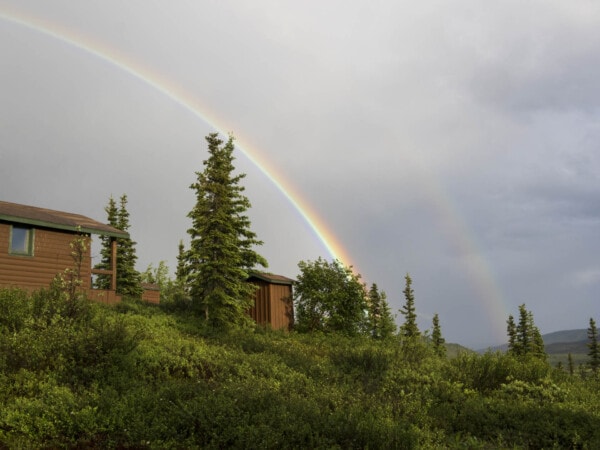






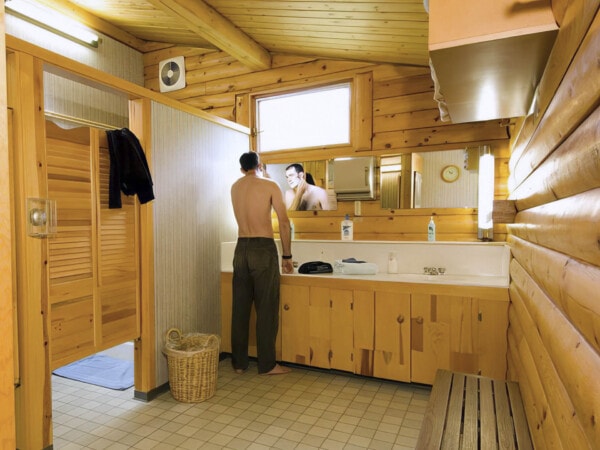








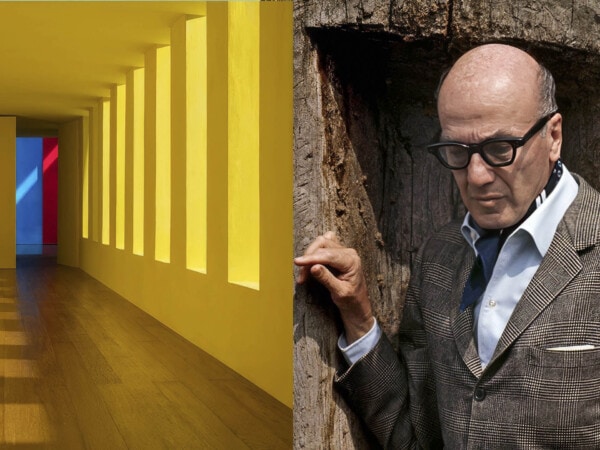
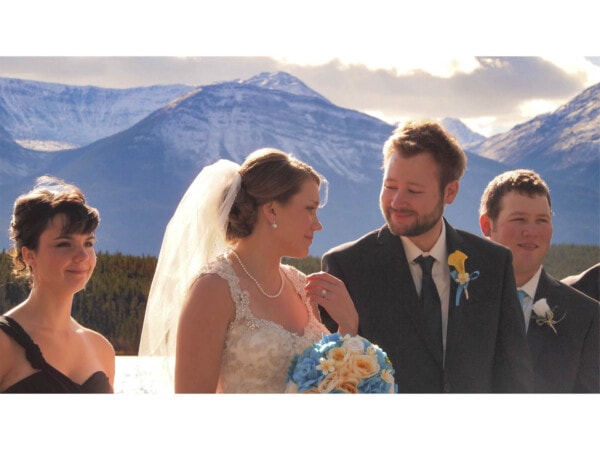
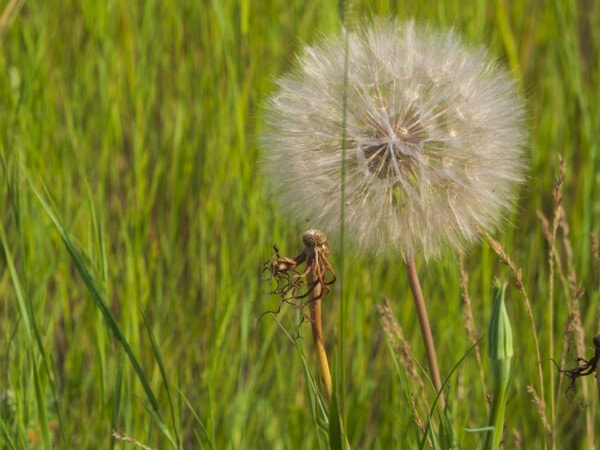

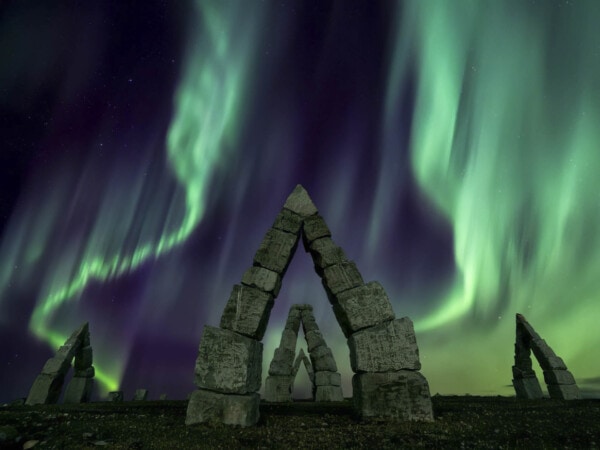
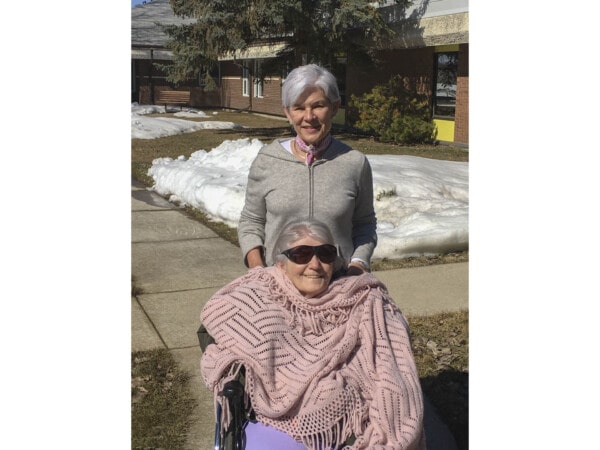
6 Responses
Great post and pictures!!
TY Joan. A labour of love.
Oh how we long to go back. Your lovely writing perfectly captures the experience.
TY Scott. Longing to go back, too. Let’s hope it’s not too long before we can.
True Alaska pioneers, and WWII fighter pilots in addition. Impressive camp they founded.
So true Greg. The older we become the more we marvel at those who opened up the world to us, people like Ginny and Celia in Alaska.